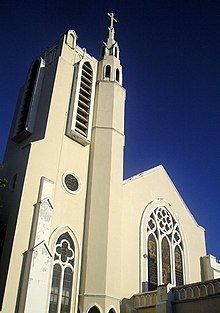Tarlac Province
| Basic data | |
|---|---|
| Region : | Central Luzon |
| Capital : | Tarlac City |
| Population : | 1,366,027 August 1, 2015 census
|
| Population density : | 407 inhabitants per km² |
| Area : | 3,358.99 km² |
| PSGC : | 036900000 |
| Official website: | http://tarlacprovince.com/ |
| structure | |
| - Highly urbanized cities | 1 |
| - provincial cities | 1 |
| - municipalities | 17th |
| - Barangays | |
| - electoral districts | 3 |
| Location of the province on the island of Luzon | |

|
|
Coordinates: 15 ° 30 ′ N , 120 ° 30 ′ E
Tarlac is an inland province on the island of Luzon ( Philippines ). The population is 1,366,027 (census August 1, 2015) and the area is 3358.99 km². The capital of the province is Tarlac City and belongs to the Central Luzon administrative region . The province is described as wealthy, it belongs to the first income bracket of the provinces in the Philippines.
geography
The province of Tarlac is located in the northwest of the Great Central Plain on the island of Luzon. Its neighboring provinces are Pangasinan in the north, Nueva Ecija in the east, Pampanga in the south and Zambales in the east. Most of the province is flat, only in the west of the province is it mountainous. There are the foothills of the Zambales Mountains . In the southeast, smaller parts of the province lie on the mountain flanks of the Arayat volcano . The largest river in the province is the Tarlac River , its source is on Mount Pinatubo .
climate
The province's climate is divided into a rainy season, from May to October, and a dry season, from November to April. The rainiest months are July, August and September with average rainfall around 400 mm / m². The average annual temperature is 26.11 ° C.
languages
The most widely spoken languages in the province are Ilokano (44.0%) and Kapampangan (43.6%). Tagalog (10.6%), Pangasinian (0.7%) and other languages and dialects (approx. 1.1%) follow far behind .
history
In the pre-colonial era, the province was covered by thick vegetation , mostly rainforest . The population consisted mainly of nomadic tribes and peoples such as the Aeta , who are still considered the Aborigines of the Philippines to this day. The name Tarlac is derived from a term for Talahiblike grass, which is called "Matarlak" in the language of the Aetas.
The forerunner of the province was the military administrative district Comandancia-Militar de Tarlac , which was established in 1858. The province was the last province on Luzon to be founded by the Spanish colonial administration on May 28, 1873, the first governor was Don Juan Guillen. The province was formed by the amalgamation of the provincial administrative districts of Southern Pangasinan and Northern Pampanga.
Tarlac Province was a starting point for the Filipino Revolution . The province still represents one of the eight rays in the flag of the Philippines . The revolution began in Tarlac on January 24, 1897 with the so-called Cry of Tagumpay . Later during the Philippine-American War , the city of Tarlac was briefly the seat of the government of the first Philippine Republic under General Emilio Aguinaldo , from June 21 to November 10, 1899. During World War II, the O`Donnell prisoner-of-war camp was located in Capas Bataan Death March 1942.
Administrative division
The administration of the province is divided into 3 congress districts and a total of 17 municipalities and a component city.
city
Communities
Educational institutions
politics
The province has three constituencies for the House of Representatives of the Philippines .

